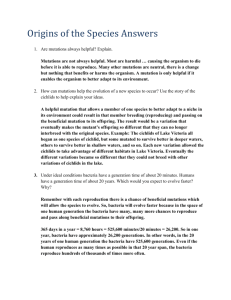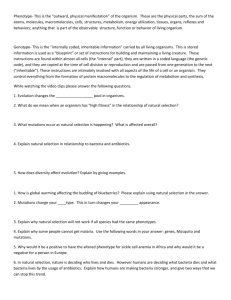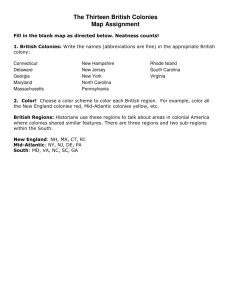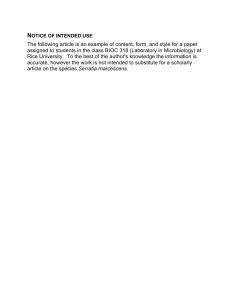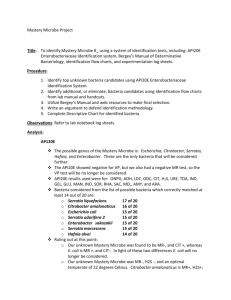Abstract This lab was done on mutations, specifically mutations on
advertisement
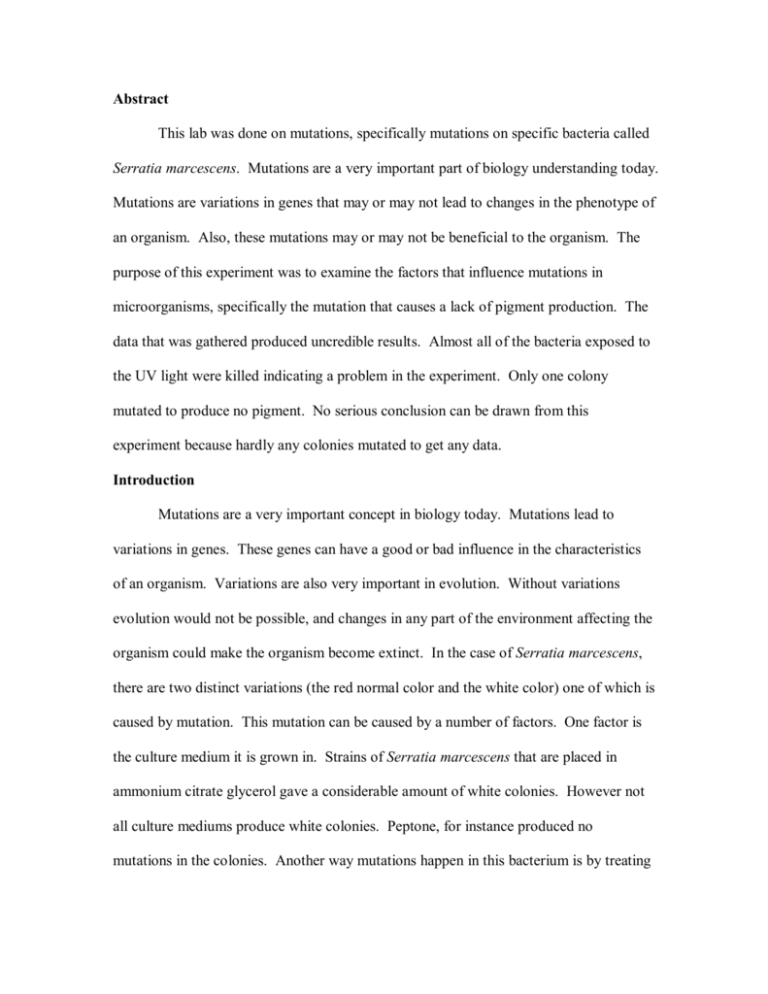
Abstract This lab was done on mutations, specifically mutations on specific bacteria called Serratia marcescens. Mutations are a very important part of biology understanding today. Mutations are variations in genes that may or may not lead to changes in the phenotype of an organism. Also, these mutations may or may not be beneficial to the organism. The purpose of this experiment was to examine the factors that influence mutations in microorganisms, specifically the mutation that causes a lack of pigment production. The data that was gathered produced uncredible results. Almost all of the bacteria exposed to the UV light were killed indicating a problem in the experiment. Only one colony mutated to produce no pigment. No serious conclusion can be drawn from this experiment because hardly any colonies mutated to get any data. Introduction Mutations are a very important concept in biology today. Mutations lead to variations in genes. These genes can have a good or bad influence in the characteristics of an organism. Variations are also very important in evolution. Without variations evolution would not be possible, and changes in any part of the environment affecting the organism could make the organism become extinct. In the case of Serratia marcescens, there are two distinct variations (the red normal color and the white color) one of which is caused by mutation. This mutation can be caused by a number of factors. One factor is the culture medium it is grown in. Strains of Serratia marcescens that are placed in ammonium citrate glycerol gave a considerable amount of white colonies. However not all culture mediums produce white colonies. Peptone, for instance produced no mutations in the colonies. Another way mutations happen in this bacterium is by treating them with nitrogen mustard. This produced a high frequency of mutation in the bacteria and made a clear conclusion that some forms of mutagens produce a form of white colonies (Bunting and others 1951). In this experiment ultra violet light was used was used to produce the mutations. More importantly the purpose of this experiment was to examine the mutation frequencies in bacteria using mutagens such as UV light. Seeing the mutations formed will help better understand if the intensity of the UV light has anything to do with the mutations HA: The intensity of the UV light does affect the rate of mutation in Serratia marcescens. HO: The intensity of the UV light does not affect the rate of mutation in Serratia marcescens. Methods and Materials This experiment was done on March 2, 2004 at 11:00 am. in the Manchester College science building. 9 Petri dishes, ultra violet light, bacteria Serratia marcescens, and a culture to grow the bacteria were used in this experiment. All of the Petri dishes will contain the bacteria but 3 will not be exposed to the UV light. 3 others will be exposed to the UV light 19 cm from the source of the light (farthest distance away from the light). Another 3 will we exposed to the UV light 9.5 cm away (half the distance from the table to the source). The cultures will be exposed for 4 seconds then put in a dark drawer to grow. They will be examined 24 and 48 hours later to count the number of bacteria colonies, and the number of bacteria colonies that have mutated as a result of the UV light. After examination, the mutation frequency will be figured out. Mutation frequency = number of mutations / number of cells (colonies). This experiment is very structured and straight forward; thus, if the steps are followed, the experiment can be easily repeated. Results When the bacteria were examined after 24 hours of growth, the background which was the Petri dishes that were not exposed to the UV light contained many normal (red) bacteria. However the bacteria that were exposed to UV light contained little or no normal colonies or mutated colonies. 24 hours after exposure Background Background Background 19 cm 19 cm 19 cm 9.5 cm 9.5 cm 9.5 cm Normal (red) colonies 430 270 240 0 0 0 3 0 0 Mutated (white) colonies 0 0 0 0 0 0 0 0 0 Total 430 270 240 0 0 0 3 0 0 The same is true after examining the bacteria after 48 hours. This time however, more normal bacteria had grown in the dishes that were exposed to the UV light. Only one mutated colony had grown over the 48 hour period. 48 hours after exposure Background Background Background 19 cm 19 cm 19 cm 9.5 cm 9.5 cm 9.5 cm Normal (red) colonies 520 290 280 22 2 5 3 0 0 Mutated (white) colonies 0 0 0 1 0 0 0 0 0 Total 520 290 280 23 2 5 3 0 0 Discussion Based on the experiment, the null hypothesis is accepted because the intensity of the UV light does not affect the mutation rate. Based on the number of colonies in the Petri dishes that were exposed to the UV light, it can be said that the UV light sufficiently reduced the number of colonies that formed. Only the colonies that were exposed to the UV light at 19 cm produced credible results. The only sufficient number of colonies that formed was on the dishes that were not exposed to the UV light. Furthermore, the amount of colonies that mutated was next to none. The main cause of this problem was probably that the bacteria were exposed to the UV light to long thus killing the bacteria. With no mutated colonies to get data from it is impossible for the mutation frequency to be calculated. If this experiment is to be repeated in the future, the time the bacteria is exposed to the UV light should be greatly reduced in order to get mutations. Literature Cited Bunting Mary, Labrum Lewis, Hemmerly Jean. September­October 1951. The Effect of Nutrition of the Production and Stability of an Unstable White Color­Variant of the HY Strains of Serratia Marcescens. The American Naturalist. 824:331­32. The Effect of Ultraviolet Light on Serratia Marcescens Ryan Evans Lab Partners: Eli Hershberger, Tim Day Lab Assistant: Laura Combs Tuesday 11:00 – 12:50 Principles of Biology II Lab 3/7/2004



